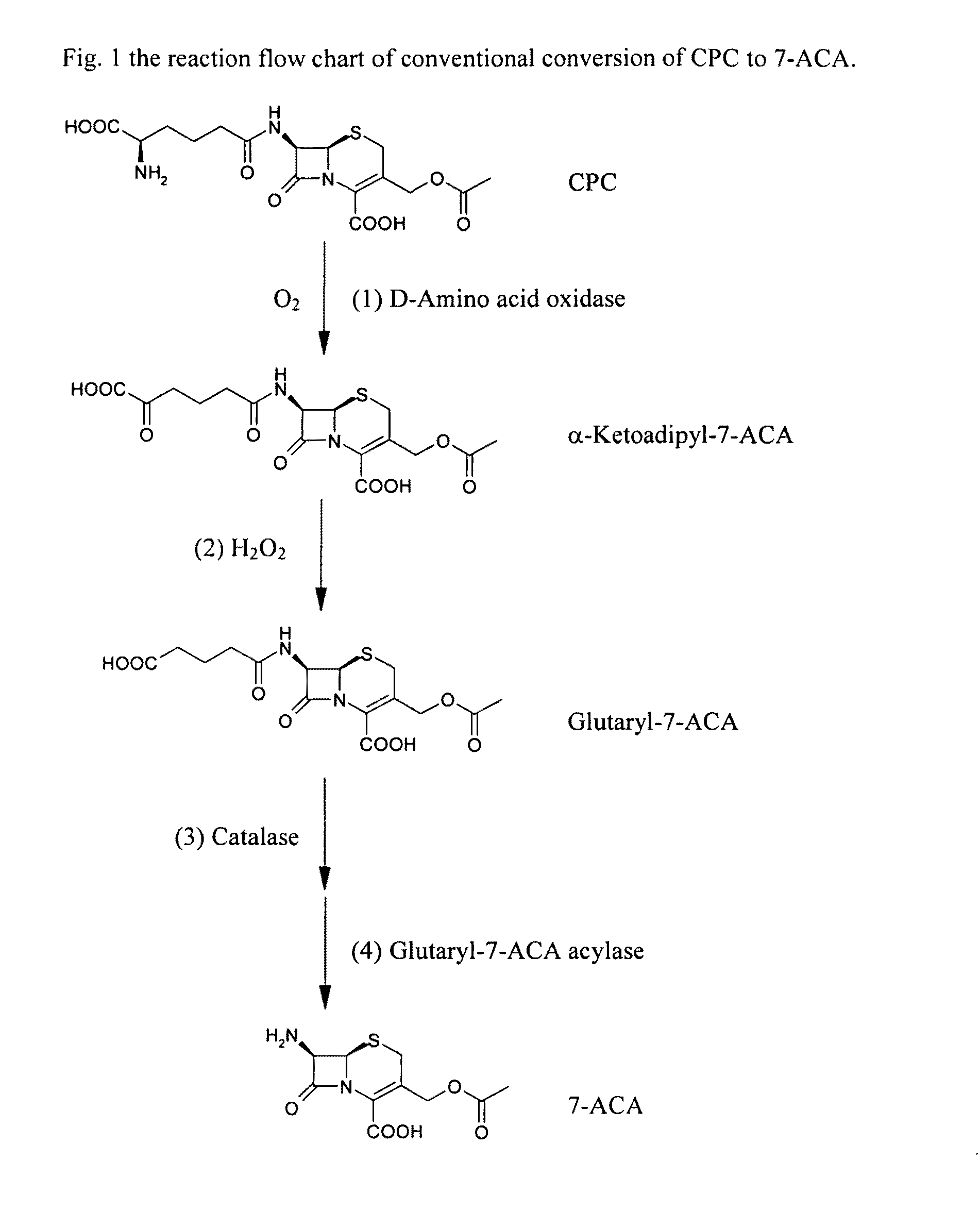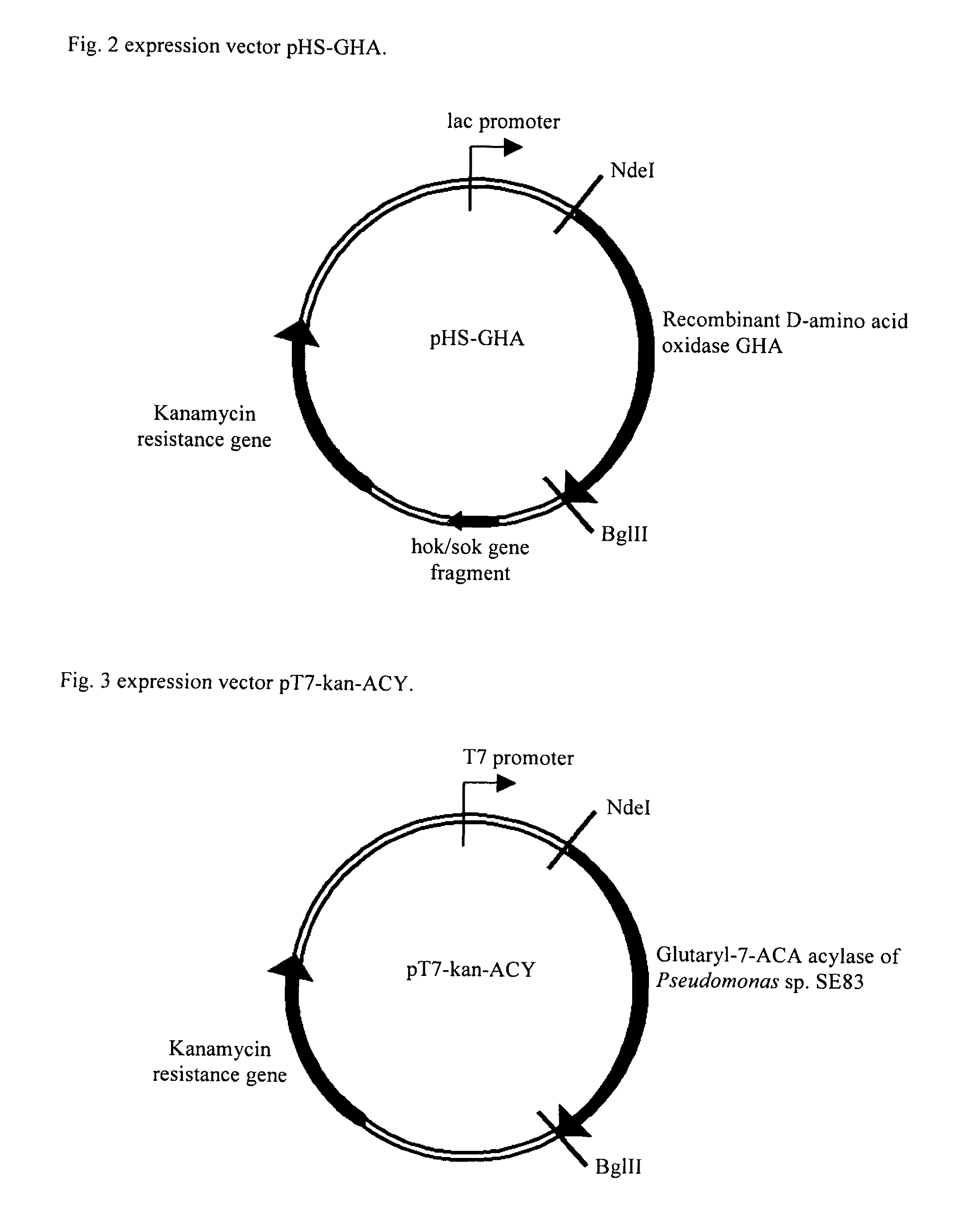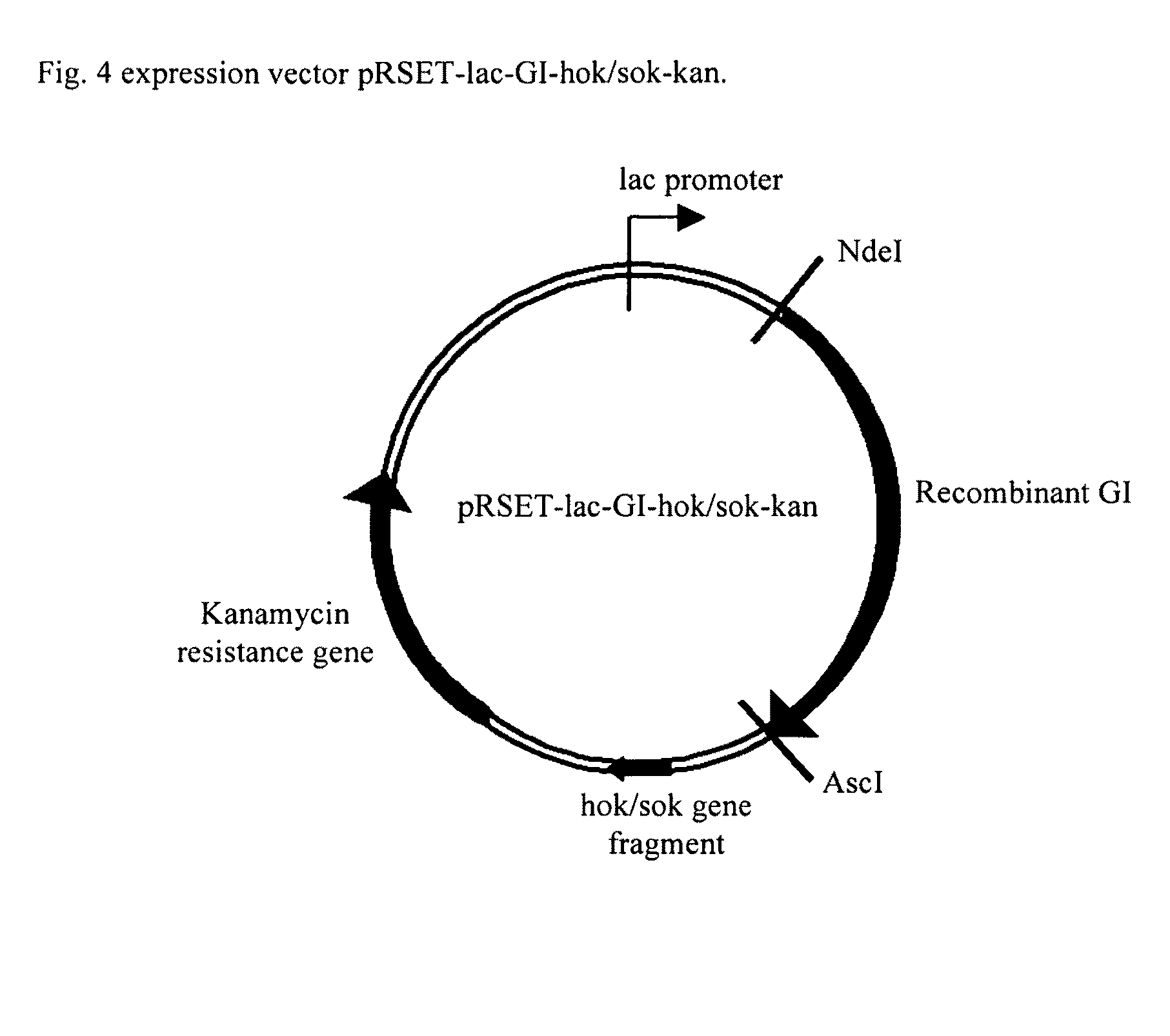Two-step enzyme method for preparing 7-aminocephalosporanic acid
a technology of aminocephalosporanic acid and enzyme method, which is applied in the field of biotechnology, can solve the problems of low conversion rate and high cost, low yield and high cost of 7-aca production, and achieve the effects of reducing production cost, saving production cost, and simplifying manufacturing procedures
- Summary
- Abstract
- Description
- Claims
- Application Information
AI Technical Summary
Benefits of technology
Problems solved by technology
Method used
Image
Examples
example 2
Construction of Vector pRSET-lac-kan
[0034]The following primers were synthesized based on the sequence of pGEMT-Easy (Promega):
[0035]
RBS-NdeI(SEQ ID NO: 12)5′-CATATGTATATC TGTGTGAAATTG-3′(NdeI restriction site is underlined and ribosomebinding site is marked by broken underline);RBS-AlwNI(SEQ ID NO: 13)5′-CAGTGGCTGCTGCCAGTGGCGATAAGTC-3′(AlwNI restriction site is underlined).
[0036]PCR was performed using pGEMT-Easy (Promega) as template to generate a 755 bp PCR product. PCR mixture contained 50 ng pGEMT-Easy (Promega), 0.4 μM RBS-NdeI, 0.4 μM RBS-AlwNI, 50 μM dATP, 50 μM dTTP, 50 μM dCTP, 50 μM dGTP, 20 mM Tris-HCl (pH8.8), 10 mM KCl, 10 mM (NH4)2SO4, 2 mM MgSO4, 0.1% Triton X-100, 2.5 U Pfu DNA polymerase (Promega). The volume of the mixture was made up to 50 μL with sterile deionized water.
[0037]PCR profile was as follows:
[0038]
[0039]The PCR product (755 bp) contains NdeI restriction site and ribosome binding site at the 5′ end and AlwNI restriction site at the 3′ end. The PCR prod...
example 3
Construction of Vector pGEMT-Easy-GI
[0041]The following primers were synthesized based on the sequence of known Thermoanaerobacterium saccharolyticum glucose isomerase gene (GenBank L09699).
[0042]
GI-NdeI(SEQ ID NO: 14)5′-CATATGAATAAATATTTTGAGAACGTATCTAAAATA-3′(NdeI restriction site is underlined);GI-EcoRI(SEQ ID NO: 15)5′-GATATCTTAAGGCGCGCCTTATTCTGCAAAC-3′(EcoRI restriction site is underlined and AscIrestriction site is double underlined).
[0043]PCR was performed using Thermoanaerobacterium saccharolyticum (purchased from ATCC, USA) DNA as template to generate a 1,336 bp PCR product. PCR mixture contained 50 ng T. saccharolyticum DNA, 0.4 μM GI-NdeI, 0.4 μM GI-EcoRI, 50 μM dATP, 50 μM dTTP, 50 μM dCTP, 50 μM dGTP, 20 mM Tris-HCl (pH8.8), 10 mM KCl, 10 mM (NH4)2SO4, 2 mM MgSO4, 0.1% Triton X-100, 2.5 U Platinum Taq High Fidelity DNA polymerase (Invitrogen). The volume of the mixture was made up to 50 μL with sterile deionized water.
[0044]PCR profile was as follows:
[0045]
[0046]The PCR ...
example 4
Construction of Vector pRSET-lac-GI-hok / sok-kan (FIG. 4)
[0047]Vector pGEMT-Easy-GI was cut by NdeI and EcoRI and resolved in 0.8% agarose, purified and ligated to NdeI / EcoRI-digested pRSET-lac-kan, generating pRSET-lac-GI-kan. The plasmid was used to transform competent E. coli BL21(DE3)pLysS (Novagen), spread onto LB agar containing 50 μg / mL kanamycin and incubated at 37° C. overnight.
[0048]Plasmid was extracted in accordance with Molecular Cloning—A Laboratory Manual (Sambrook, J. et al., 1989, CSHL Press).
[0049]Ten primers (SEQ ID NOS. 16-25) were synthesized based on known hok / sok gene sequence (GenBank X05813) (Table 1). PCR gene assembly was performed as described by Kikuchi, M. et al., 1999, Gene 236:159-167, with modifications. PCR mixture contained 20 ng each primer, 50 μM dATP, 50 μM dTTP, 50 μM dCTP, 50 μM dGTP, 20 mM Tris-HCl (pH8.8), 10 mM KCl, 10 mM (NH4)2SO4, 2 mM MgSO4, 0.1% Triton X-100, 2.5 U Pfu DNA polymerase (Promega). The volume of the mixture was made up to 50...
PUM
| Property | Measurement | Unit |
|---|---|---|
| volume | aaaaa | aaaaa |
| pH | aaaaa | aaaaa |
| pH | aaaaa | aaaaa |
Abstract
Description
Claims
Application Information
 Login to View More
Login to View More - R&D
- Intellectual Property
- Life Sciences
- Materials
- Tech Scout
- Unparalleled Data Quality
- Higher Quality Content
- 60% Fewer Hallucinations
Browse by: Latest US Patents, China's latest patents, Technical Efficacy Thesaurus, Application Domain, Technology Topic, Popular Technical Reports.
© 2025 PatSnap. All rights reserved.Legal|Privacy policy|Modern Slavery Act Transparency Statement|Sitemap|About US| Contact US: help@patsnap.com



